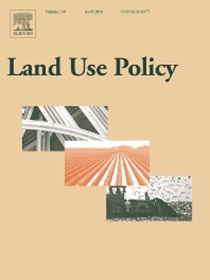新型优质生产力与新型城镇化:中国耦合协调与影响因素分析
IF 5.9
1区 社会学
Q1 ENVIRONMENTAL STUDIES
引用次数: 0
摘要
当前,中国正处于传统产业创新升级、高质量城镇化转型的关键时期。新型优质生产力(NQPF)将重新定义中国新型城镇化的轨迹。然而,空间格局的内在规律及其相互作用的决定因素仍需进一步探索。本研究建立了多维指标体系,并计算了权重。运用耦合协调度模型(CCDM)、地理探测器、地理加权回归模型、时间预测模型等多种分析工具,对全国283个地级市的NQPF与NTU的耦合协调机制进行了系统研究。NQPF和NTU水平均呈现稳定增长趋势,空间格局均呈现东高西低梯度,与城市社会经济水平密切相关。中国城市CCD从2000 - 2022年的0.476上升到0.665,东北、中部和西部地区持续低于东部地区。这四个主要区域之间的CCD水平差距继续扩大,预测表明这种差距将持续到2030年。南洋理工大学的发展水平已成为影响其生态平衡的主要障碍,其中社会城市化和空间城市化是最大的障碍。在影响因素中,制造业员工数量等8个指标可以有效提高耦合协调水平。扬尘排放、废气排放等指标间的非线性交互作用增强了CCD,但12个典型指标的作用系数由于区域资源禀赋差异呈现出显著的空间异质性。研究成果为解决NQPF和NTU发展中的结构性矛盾提供了理论支撑,为中国生产力创新与城镇化跨越式发展协调推进提供了路径指导。本文章由计算机程序翻译,如有差异,请以英文原文为准。
New quality productive forces and new-type urbanization: Analysis of coupling coordination and influencing factors in China
China is currently in a pivotal phase of innovation and upgrading traditional industries, as well as transforming urbanization towards a high-quality model. The New Quality Productive Forces (NQPF) are poised to redefine the trajectory of China's New-Type Urbanization (NTU). However, the internal laws of spatial patterns and the determinants of their interactions still require further exploration. This study develops a multi-dimensional index system and calculates the weights. It then employs various analytical tools, including the coupling coordination degree model (CCDM), geographical detector, geographically weighted regression model, and time prediction model, to systematically examine the coupling coordination mechanism between NQPF and NTU in 283 prefecture-level cities nationwide. The levels of NQPF and NTU both exhibited a steady growth trend, and their spatial patterns both displayed an east-high and west-low gradient, closely correlating with the socio-economic levels of cities. The CCD in China's urban increased from 0.476 in 2000–0.665 in 2022, with the Northeast, Central, and Western regions consistently below the Eastern region. The gap in CCD levels among these four major regions continued to widen, and predictions indicate that this disparity will persist until 2030. The development level of NTU has become the main obstacle to enhancing the CCD, with social and space urbanization posing the greatest obstacles. Among the influencing factors, eight indicators such as the number of manufacturing employees can effectively improve the coupling coordination level. Non-linear interaction among dust emissions, waste gas emissions, and other indicators can enhance the CCD, while the action coefficients of 12 typical indicators show significant spatial heterogeneity due to regional resource endowment differences. The research results provide theoretical support for resolving the structural contradictions in the development of NQPF and NTU, and offer path guidance for the coordinated and mutually-promoting progress of China's productivity innovation and urbanization leap-forward development.
求助全文
通过发布文献求助,成功后即可免费获取论文全文。
去求助
来源期刊

Land Use Policy
ENVIRONMENTAL STUDIES-
CiteScore
13.70
自引率
8.50%
发文量
553
期刊介绍:
Land Use Policy is an international and interdisciplinary journal concerned with the social, economic, political, legal, physical and planning aspects of urban and rural land use.
Land Use Policy examines issues in geography, agriculture, forestry, irrigation, environmental conservation, housing, urban development and transport in both developed and developing countries through major refereed articles and shorter viewpoint pieces.
 求助内容:
求助内容: 应助结果提醒方式:
应助结果提醒方式:


